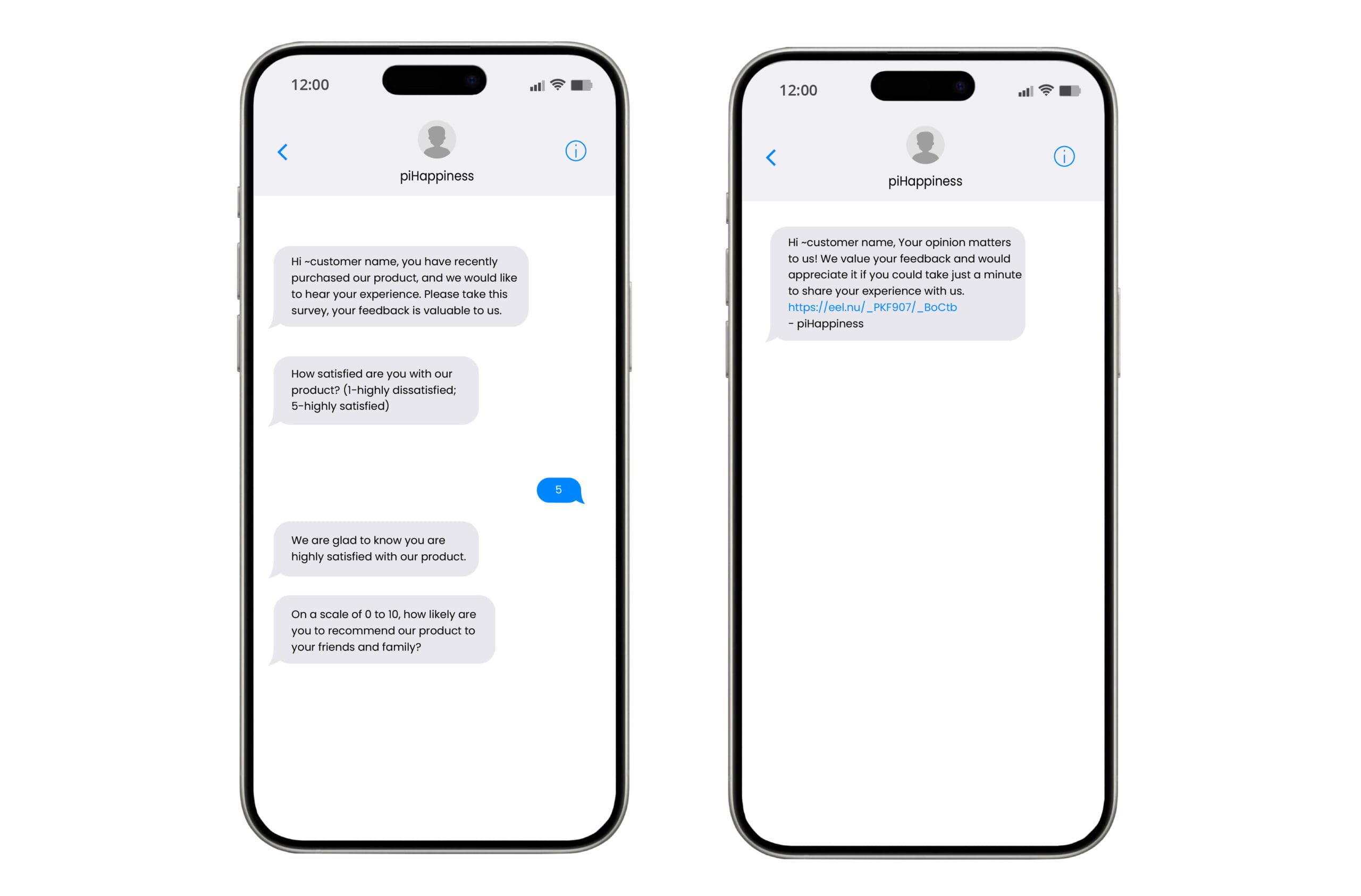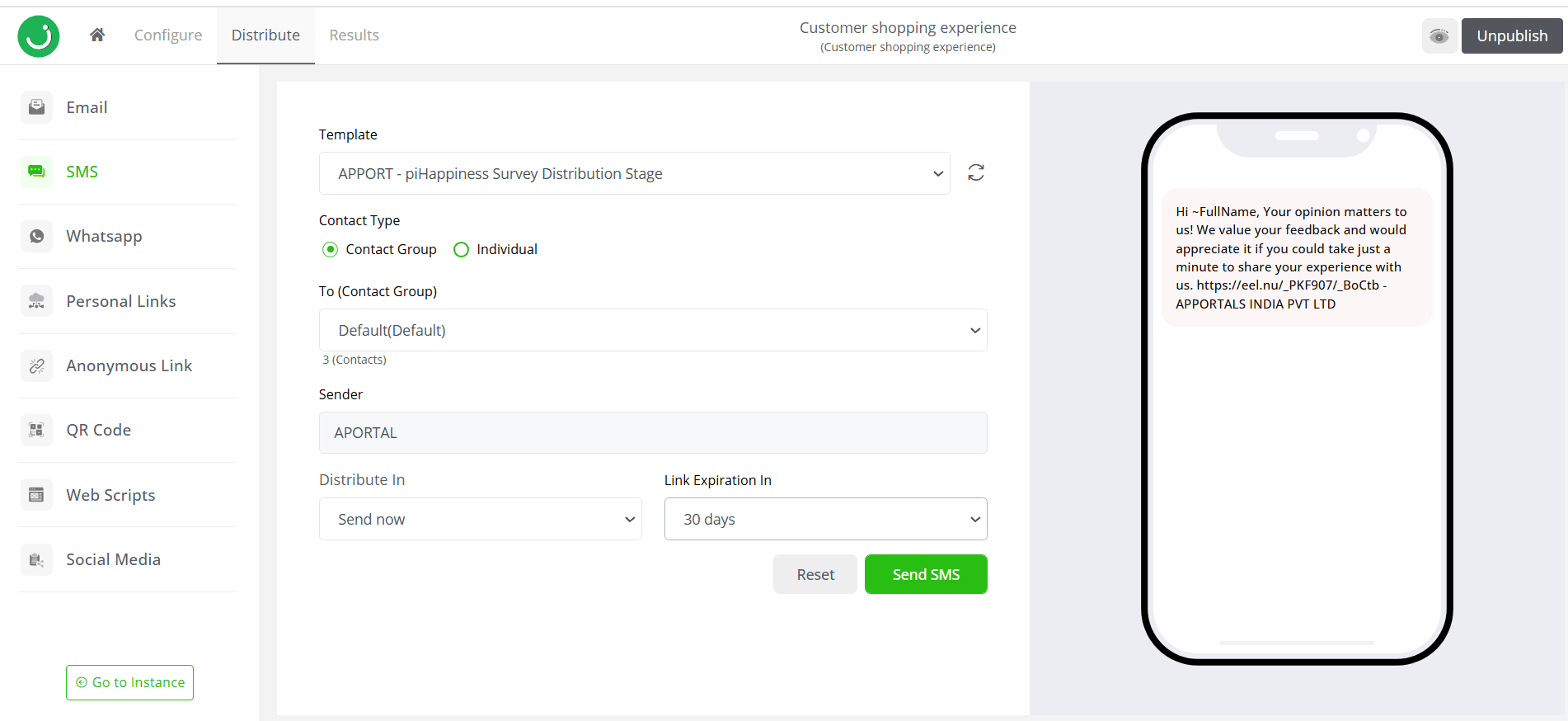What are SMS surveys?
SMS surveys are surveys sent via SMS (Short Messaging Service) to gather customer feedback. An SMS survey contains a short message along with a link. The message itself often contains just a few lines of text and a call to action, which urges customers to click on a link. This link takes them to the full survey, where they can answer questions, rate their experiences, or provide any other type of feedback.

Alternatively, you can embed the survey directly into the SMS message itself, eliminating the need for a link. This way, customers can quickly engage with the survey and do not have to leave the messaging platform. In short, SMS surveys are a modern, quick, and effective way for businesses to gather real-time feedback from their customers through a medium they are familiar with and use daily.
📩 SMS Surveys gather instant feedback via text.
🚀 Quick, engaging, and effective! ✅
Different types of SMS surveys
Now that you know what an SMS survey is, you might be wondering about the different types available. There are several kinds of surveys you can send via SMS, including:
1. Product/service feedback
These types of SMS surveys are specifically designed to collect feedback from customers who have recently purchased a product or used a service. After a customer makes a purchase, sending a product/service feedback survey allows you to evaluate how well your offering met their expectations.
- When to send? These surveys are typically sent a few days or weeks after the purchase to give customers enough time to use the product or service and form an opinion about it. This ensures the feedback is relevant and constructive.
2. Customer support feedback
Customer support feedback surveys are used to measure the experience a customer had while interacting with your support team. Key questions in these surveys often focus on the professionalism of the support staff, the resolution time, and the effectiveness of the solution provided.
- When to send? After a customer contacts your support team—whether through phone, email, or chat—it’s crucial to send an SMS survey right after the interaction to capture their immediate thoughts on the service they received.
3. Event feedback
Event feedback surveys are designed to gather attendees’ opinions and insights after a workshop or any event. Sending an event feedback survey is an excellent way to measure the success of your event and understand how to improve future ones.
- When to send? By sending an SMS survey immediately after the event, you can gauge attendees’ satisfaction with various aspects of the event.
4. Customer satisfaction (CSAT) surveys
Customer satisfaction (CSAT) surveys are one of the most common types of surveys businesses use to measure the overall satisfaction of their customers. With this type of SMS survey, you can easily ask customers to rate their level of satisfaction with a product, service, or interaction.
- When to send? CSAT surveys should be sent shortly after a customer interaction or purchase, while the experience is still fresh in their mind, to capture accurate and timely feedback.
5. Customer loyalty (NPS®) surveys
Net Promoter Score® (NPS®) surveys are used to measure customer loyalty by asking customers how likely they are to recommend your product, service, or brand to others. NPS® surveys are typically sent periodically, rather than after every interaction, to gauge long-term satisfaction and overall brand perception.
- When to send? Sending NPS® surveys at regular intervals allows you to track customer sentiment over time and make adjustments to your business strategy to foster greater loyalty and reduce churn.
Benefits of SMS surveys
So, is it really worth sending SMS surveys to your customers? Absolutely! SMS surveys have quickly gained popularity, and for good reason. Below are some of the top benefits of sending SMS surveys for customer feedback:
1. Ease of use
One of the primary reasons businesses turn to SMS surveys is because they are easy to set up and send. There is no need for complex software or detailed technical knowledge. Most survey platforms are user-friendly where you can create a survey with just a few clicks.
After designing your survey using an SMS survey tool, simply select the SMS distribution mode, pick who to send, schedule when the survey will go out, and hit “Send SMS.” That’s it! Whether you are a small business owner or part of a larger organization, SMS surveys can be up and running in no time, with minimal hassle.
2. High open rate
Arguably, the main advantage of using SMS surveys is the impressive open rate. Research from Sender shows that SMS has a 98% open rate (on average) – which is relatively the highest compared to other channels. This is especially important when you are looking to get fast, actionable feedback from your customers.
More than just high open rates, people typically open SMS messages within 3 minutes of receiving them. Due to this high open rate (that too quickly), SMS marketing is becoming popular again. And the same goes for SMS surveys. When your customers are more likely to read your survey, your response rates are sure to increase.
3. User preference
At present, convenience is king, and people are willing to pay more for better convenience. This is where SMS surveys excel. A recent survey revealed that 85% of people prefer receiving text messages over calls or emails. In fact, SMS offers a more direct, unobtrusive way to engage with customers compared to other methods.
People are more likely to check a text than to pick up an unknown phone call or read a lengthy email. By tapping into this preference, you ensure your surveys are not only seen but also acted upon by your customers. It is indeed an effective way to engage customers without interrupting their day.
4. Personalization & customization
One of the most powerful features of SMS surveys is how easily they can be personalized and customized. Personalization is an important aspect if you want to make the survey feel more relevant and tailored to the individual, rather than a generic, one-size-fits-all message. You can address customers by name, reference past purchases or interactions, and even ask specific questions based on their history with your business.
Additionally, SMS survey templates are highly customizable, so you can align them with your brand’s tone, voice, and aesthetic. When you personalize the survey, there is a high chance that it will boost engagement and make the experience feel more thoughtful to the customer, which can lead to more valuable feedback.
5. Cost-effective
Here is another primary benefit of an SMS survey – affordability. It does not cost much to create and send SMS surveys. You can send these surveys in 2 ways – manually or through a survey platform. If you choose the manual route, all you need is a device and an active SMS plan—both of which are very accessible and cost-effective. As you can see, the associated costs are quite minimal.
6. Real-time feedback
With SMS surveys, you can collect real-time feedback. Since SMS messages are typically read within minutes of being sent, you can collect valuable customer insights almost immediately. This is particularly useful for time-sensitive projects or campaigns where feedback is needed quickly to make adjustments.
Whether you want to measure customer satisfaction, get a review of a new product, or gather data after an event, SMS surveys allow you to act fast and make timely decisions based on customer feedback.
7. Broad reach
Unlike email, which can often get caught in spam filters or overlooked in crowded inboxes, SMS surveys ensure you can reach a broad audience. Since nearly everyone owns a mobile phone, sending surveys via SMS makes it easy to connect with a wider, more diverse customer base. Moreover, SMS surveys don’t require an internet connection, which means your customers can respond regardless of their data plan or Wi-Fi access.
Creating and sending SMS surveys: Best practices & tips
Here are a few tips you can follow while creating and sending SMS surveys to capture customer attention and enhance response rate:
- Finalize the survey type: List out the objectives, which will help you determine the survey type. Based on that, you can add relevant survey questions.
- Keep it short: Always remember that ‘short is sweet’ so keep the SMS length short. Stick to a short, 3- or 4-line message that gets straight to the point. Remember, your customers are likely to be on the go, so the quicker and easier you make it for them to respond, the better your chances of getting valuable feedback.
- Use simple language: There is no point in using complex language if your customers are having a hard time understanding it. So, it’s better to use simple, easy-to-understand language. The goal is to make your survey as user-friendly as possible, so choose simple, straightforward language.
- Personalize the message: If you want your customers to feel valued, personalize the SMS survey. Address them by name, and if possible, reference any past interactions or purchases to make the survey feel more relevant.
- Send at the right time: Choose the appropriate time to send the SMS survey. Avoid sending surveys late at night or over the weekend when they may be ignored. The ideal time to send SMS surveys is typically between 8 am and 6 pm on weekdays.
- Add opt-out button: Make sure to send the SMS surveys to customers who gave prior permission. Also, always include an opt-out option for your customers to unsubscribe from future surveys. This ensures that you are respecting their preferences and complying with regulations.
- Choose the right SMS survey software: Selecting the right survey platform can make all the difference. A reliable SMS survey software can make survey creation and analysis easier, quicker, and much more efficient.
- Analyze the feedback: Once the survey has been filled in, you can see the real-time responses. Analyze the feedback, find patterns, and make changes accordingly to improve customer experience.
Wrapping Up
Due to their simplicity, high open and click-through rates, and affordability, SMS surveys are commonly used by businesses to gather real-time and instant feedback from customers. Whether you want to gather product feedback, measure customer satisfaction, or want to know about any aspect related to customers, SMS surveys are the most ideal.
piHappiness is a customer experience platform that allows you to send SMS surveys to your customers easily. There are different SMS templates to choose from, you can schedule the survey at any time and get access to real-time analytics and live reports. Fill this form to get started or directly schedule a demo here.









